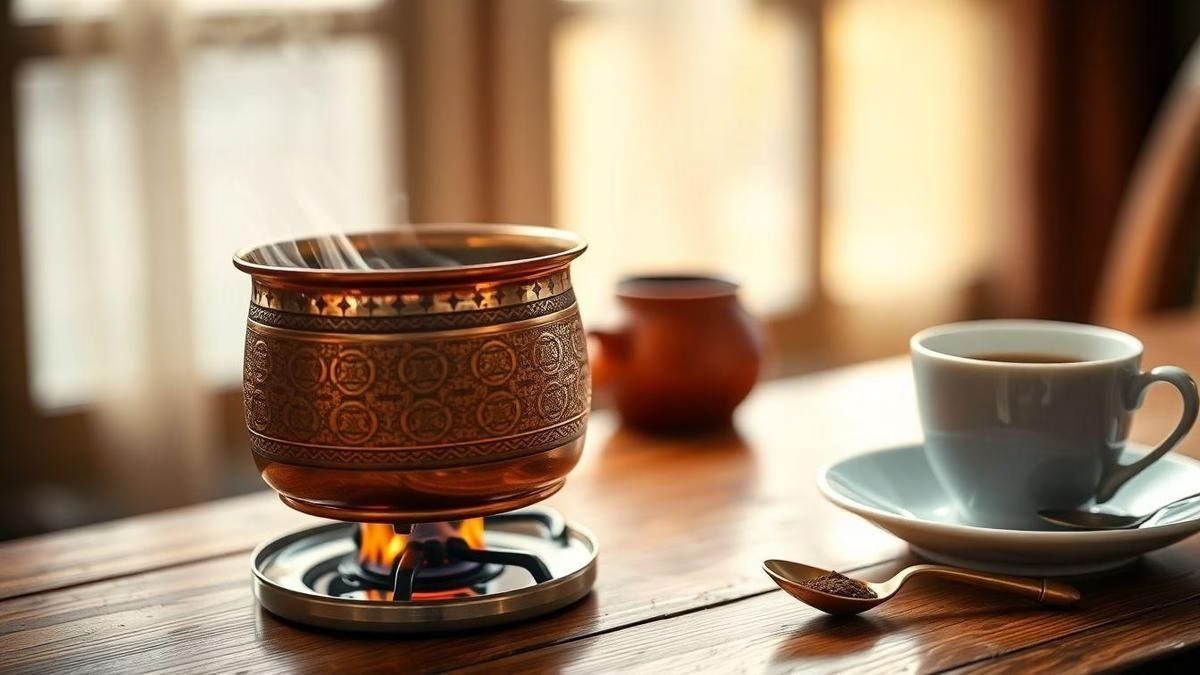Easy Guide to Making Turkish Coffee at Home
You get the essential tools like a cezve, small cups, and a spoon. You learn to use fresh cold water, ultra-fine coffee, and simple sugar measured by teaspoon. You master the right grind size, bean roast and freshness, plus a fingertip grind test. You follow a clear stovetop method, watch for tiny bubbles, and keep rich foam with slow heat and gentle pouring. You also learn serving traditions, quick foam fixes, and simple cleaning and storage tips so your next brew is always perfect.
Key Takeaway
- Use very finely ground coffee and cold water in your cezve.
- Add sugar to your cezve now if you like it sweet.
- Heat it slowly on low until foam rises.
- Take it off the heat when foam forms, then put it back once for more foam.
- Pour slowly and let the grounds settle before you sip.
Essential tools and ingredients you need for authentic Turkish coffee
Start simple and you’ll be sipping like a neighbor at a Bosphorus café. For a true cup you want a cezve (the small long-handled pot), ultra-fine coffee ground for Turkish style, fresh cold water, small porcelain cups (fincan), and a tiny spoon. Each piece changes how the foam, strength, and flavor show up in your cup. This Easy Guide to Making Turkish Coffee at Home begins with these basics so you can focus on technique, not guesswork. For a concise overview of traditional equipment, read Choosing the right cezve and cups for brewing.
“Coffee should be black as hell, strong as death, and sweet as love.”
Pick materials that help heat gently. A copper or brass cezve with a tin lining heats evenly and helps foam form. If you use stainless steel or a thick-bottomed cezve, adjust the heat slightly lower. Smaller cezves keep the brew concentrated and make foaming easier than a big pot.
Measure water by the cup you will serve in and use a small measuring spoon for coffee and sugar. A low flame on a gas stove or an electric hotplate gives steady control. Keep a clean, fine sieve or cloth nearby if you want to remove grounds later, though leaving grounds in the cup is traditional.
Pick the right cezve, small cups, and a spoon for stovetop Turkish coffee
Choose a cezve that fits the number of cups you plan to make. A 300–400 ml cezve is great for two to three demitasses; a 150–200 ml cezve matches one or two cups. Long handle, narrow neck, and wide base help foam build and last—prioritize shape over flashy design.
Use porcelain fincan that hold about 60–80 ml. Porcelain keeps the temperature even and makes the coffee feel richer. Use a slim spoon for stirring and serving foam. For best foam, use a cezve sized slightly larger than the volume you plan to brew. Less crowding = bigger foam.
Use fresh cold water, ultra-fine coffee, and sugar measured by teaspoon
Always start with fresh cold water. Measure about 60 ml (2 fl oz) per cup. Add one heaped teaspoon of ultra-fine Turkish coffee per cup. If you grind at home, aim for a powder finer than espresso; it should feel like flour between your fingers. Add sugar to taste in teaspoons before you heat the cezve so it dissolves evenly.
Sugar scale: 0 tsp = sade (no sugar), 1/2 tsp = light, 1 tsp = medium, 2 tsp = sweet. Stir the coffee, water, and sugar together well before you place the cezve on heat. Do not stir after the foam starts to rise — that will break it. Let the foam form slowly over low heat and scoop a little foam into each cup before you pour the rest.
Simple shopping and prep checklist with exact amounts
Buy these to make one to four cups without guesswork. Store coffee airtight and grind just before use if you can.
| Item | Amount per cup | Notes |
|---|---|---|
| Ultra-fine Turkish coffee | 1 heaped teaspoon (≈5–7 g) | Grind very fine or buy labeled Turkish grind |
| Fresh cold water | 60 ml (2 fl oz) | Measure by the cup you’ll serve in |
| Sugar | 0–2 teaspoons | Add before heating; choose sweetness level |
| Cezve | 1 | Small copper/brass or stainless steel; size to cups |
| Porcelain cups (fincan) | 1 per person | Hold 60–80 ml |
| Small spoon | 1 | For stirring and serving foam |
| Heat source | — | Low flame or hotplate; gentle, even heat builds foam |
How to choose the correct Turkish coffee grind size and beans
You want that thick, velvety cup with a layer of foam on top. Pick an ultra-fine grind that feels like powdered sugar. If your grounds are coarser, the water won’t suspend them properly and you’ll miss the texture and flavor that make Turkish coffee special.
Bean choice shapes the flavor. Fresh 100% Arabica brings cleaner, fruity notes; a touch of Robusta adds body and bigger foam. Medium to medium-dark roasts give caramel, nutty, and chocolate tones that stand up well to dense extraction. Keep beans in a cool, airtight container and grind right before brewing so the oils stay lively. Learn more about varietals at Selecting beans and understanding coffee varieties.
Tip: Start with one recipe—1 heaping teaspoon per 60 ml, your preferred sugar level, cold water, and low heat—and tweak from there.
| Grind look/feel | What it does in the cup | When to use |
|---|---|---|
| Powdery, like flour or powdered sugar | Suspends in water, creates dense body and foam, leaves fine sediment | Classic Turkish coffee |
| Slightly gritty (too coarse) | Fast extraction, thin body, weak foam | Avoid for traditional method |
| Very oily clumpy (overground or stale) | Muted aromatics, flat taste, clogging | Fresh grind preferred; discard clumpy grounds |
Quick test to check your grind size
Pinch a tiny amount between fingertip and thumb: it should feel like talcum powder and not leave coarse grains. Visually, the grounds look matte, fine, and consistent — not sandy, not clumpy.
Step-by-step stovetop Turkish coffee method you can follow
This Easy Guide to Making Turkish Coffee at Home shows a simple stovetop route: measure, mix, place on low heat, watch the foam, and serve slowly into small cups. Work slowly over low heat and enjoy the ritual. Scoop foam between cups first, then fill the rest. For general brewing tips that apply across methods, see industry guidance on Slow stovetop brewing and foam technique.
Instructions: measure, mix, and place on low heat
Measure one heaping teaspoon (≈6 g) per small cup (about 60 ml) and add cold water to the cezve. Add sugar now if you like it: none for sade, 1/2 tsp for light, 1 tsp for medium, 2 tsp for sweet. Stir once to combine coffee, sugar, and water until everything dissolves.
Place the cezve on the smallest flame or lowest heat. Do not stir after you start heating. Watch for foam forming and small bubbles along the edge. Let the foam rise gently; lift the cezve off the heat when the foam swells toward the center. If foam threatens to spill, take it off immediately, wait a few seconds, then return briefly to let it rise again.
Timing and what to watch for to avoid overboiling
When you see tiny bubbles forming at the edges and the foam starts to swell toward the center, lift the cezve off the heat. The foam builds fast, so be ready to pull it away before it overflows. Avoid a rolling boil — boiling destroys the foam and makes the coffee thin and bitter. Lift the cezve twice (letting foam rise each time), then pour slowly so the foam divides evenly. Serve warm and let the grounds settle for a minute before sipping.
One simple recipe with repeatable ratios
Use 1 heaping teaspoon (≈6 g) Turkish coffee per 60 ml cold water. For sugar, choose: 0 tsp (sade), 1/2 tsp (light), 1 tsp (medium), 2 tsp (sweet). Stir once before heating, heat low, lift at the first foam rise, repeat once, then pour.
| Serving | Water (ml) | Coffee (g) | Coffee (heaping tsp) | Sugar (tsp) |
|---|---|---|---|---|
| 1 cup | 60 | 6 | 1 | 0 / 0.5 / 1 / 2 |
| 2 cups | 120 | 12 | 2 | 0 / 1 / 2 / 4 |
Master the Turkish coffee foam technique and simple brewing tips
You want glossy, velvety foam—kahve kaymağı—sitting proud on your cup. Foam comes from slow heat and gentle handling, not force. Measure well: about 1 heaping teaspoon of coffee per small cup. Put coffee and cold water in the cezve, stir once before heating, and place on low heat. Remove the cezve the moment foam begins to rise and before it boils over.
Think of foam like a delicate hat: after the first rise, let it settle a few seconds, then give it one gentle reheating if needed. With a calm hand you’ll coax a thick crown each time.
| Step | What to do | Why it helps |
|---|---|---|
| Grind & Measure | Use very fine coffee; 1 heaping tsp per small cup | Fine grind extracts quickly and creates more foam |
| Heat Control | Start cold; heat on low; remove at first rise | Slow heating traps gases and forms stable foam |
| Pouring | Scoop foam into cups first, then fill gently | Preserves foam and prevents collapse during serving |
How to create and preserve foam
Slow heat is your best friend. Put the cezve on the smallest flame and watch the surface. Remove the cezve the instant foam begins to climb. Let it settle a few seconds, then warm once more if needed. Quick, high heat pops the bubbles.
Use a teaspoon to lift foam into each cup first, then pour the rest slowly from low height, aiming for the cup sides instead of the foam. Sugar helps stabilize foam a bit, so if you like sweet coffee, add sugar before heating.
Spoon-and-pause pouring method
Hold back the liquid with a spoon at the lip of the cezve and let foam flow into the cups in short bursts. Pause between pours so foam settles into a neat layer. After serving, resist stirring — let the coffee sit so the grounds settle to the bottom.
Three quick foam fixes
- Lower the heat and pull the cezve before a full boil.
- Add a small pinch of sugar or a tiny pinch of cardamom before heating to help stabilize foam.
- Use a slightly finer grind and pour foam into cups first, then fill gently.
Serving traditions, etiquette, and how to enjoy your cup
Turkish coffee is as much about the moment as flavor. Cups are small; conversations are long. Sip slowly so the grounds settle and the taste unfolds. Water and a sweet bite are offered so guests can clear the palate before and after the coffee.
Serve deliberately: pour from the cezve with care, aiming for foam in each cup. Offer a small glass of water and a sweet like Turkish delight or baklava. Present the cup on a saucer and wait for the guest to accept before you turn away. The pause after pouring shows respect for the brew and the people sharing it. For cultural background and traditional serving rituals, see Turkish coffee customs and serving etiquette.
Traditional serving steps
Let the coffee sit a moment after heating so grounds sink and foam calms. Pour slowly into porcelain cups, keeping foam on top. Always leave a little liquid in the cezve to avoid pouring grit into the last cup.
| Sugar Level (Turkish) | Spoons of Sugar | Taste Profile | Serving Note |
|---|---|---|---|
| Sade (plain) | 0 | Strong, bitter | Best with a sweet treat |
| Az şeker (light) | 1/2 | Slight sweet edge | Common choice |
| Orta (medium) | 1 | Noticeably sweet | Popular for gatherings |
| Çok şeker (very sweet) | 2–3 | Dessert-like | Pair with light snacks |
Foam fortune customs (for fun)
After drinking, flipping the cup onto the saucer and reading shapes formed by grounds is a playful tradition. Keep readings light and social.
Quick tips: place cups on saucers with a small spoon, match sugar level to guests’ tastes (ask: sade, az şeker, orta, çok şeker), and keep water handy.
Storage, cleaning, and common mistakes to avoid at home
Store ultra-fine coffee in an airtight container, away from light, heat, and moisture. Use pre-ground Turkish coffee quickly and buy small amounts. Whole beans and grinding before brewing extend freshness.
Clean the cezve by rinsing with warm water after each use and drying immediately to prevent spots. Avoid strong detergents; coffee oils carry flavor. Use a soft brush or cloth for stuck grounds. Never put the cezve in the dishwasher unless the manufacturer says it’s safe. For manufacturer-level tips on caring for copper cookware, consult Care and cleaning guidance for copper.
How to clean your cezve and store ultra-fine coffee
After each brew, dump the grounds and rinse while residue is soft. Soak briefly for stubborn residue and wipe. If your cezve is copper, polish gently occasionally. Store ultra-fine grind in a small airtight container and use within two weeks; for longer life, buy whole beans and grind just before brewing.
Tip: Rinse the cezve with warm water immediately after pouring. Coffee oils harden fast; quick rinsing stops buildup.
Common errors and quick fixes
- Too-hot boil → Bitter, lost foam. Fix: use low heat; remove cezve before it spills.
- Wrong grind (too coarse) → Watery, thin cup. Fix: use ultra-fine grind; grind beans as needed.
- Wrong ratio → Too weak or too strong. Fix: start with 1 heaping tsp per 60–70 ml; tweak by 0.5 tsp.
| Error | What happens | Quick fix |
|---|---|---|
| Too-hot boil | Bitter, burnt taste and lost foam | Use low heat; remove cezve before it spills |
| Wrong grind (too coarse) | Watery, thin cup | Use ultra-fine grind; grind beans as needed |
| Wrong ratio | Too weak or too strong | Start with 1 heaping tsp per 60–70 ml; tweak |
Simple routine: rinse cezve after each use, dry it, store coffee airtight, and grind beans before brewing. If foam fails, check grind and heat; if taste is off, adjust ratio one small step at a time.
Conclusion
You’ve got the recipe and the rhythm. Keep your cezve small, your grind ultra-fine, and your water cold. Heat slowly on low, watch for the tiny bubbles, and lift the pot before it boils. That gentle patience builds the prized foam—the crown of your cup.
Measure and tweak the ratio (about one heaping teaspoon per 60 ml) until the flavor sings. Store beans airtight, grind fresh, and rinse the cezve right after use. Little habits keep your coffee honest and your mornings smoother.
This Easy Guide to Making Turkish Coffee at Home gives you the steps, tips, and rituals to turn a few simple ingredients into a small daily pleasure. With a few tries you’ll turn this ritual into muscle memory and a warm moment to share.
Want more tips and recipes? Read more articles at https://guiabebefeliz.com.

Rafael Souza is a digital marketing specialist and passionate coffee enthusiast. He founded Guiabebefeliz to share practical, easy-to-follow guides for making great coffee at home without needing professional barista skills. His mission is to help readers enjoy better coffee experiences, one cup at a time.






